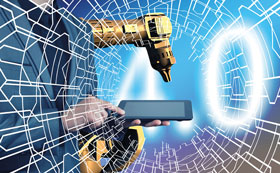

While the Internet of Things (IoT) may still be an emerging technology, it has become deeply entrenched in people’s lives and its proliferation is likely to accelerate further in the next few years.
The First Industrial Revolution, which saw the development of machine tools and the rise of the mechanised factory system, had an unprecedented effect on the way people worked and lived, leading to a massive rise in the rate of population growth. Similarly, the Fourth Industrial Revolution is expected to have an equally profound and irreversible impact on all aspects of society as it gathers momentum. IoT is rapidly driving the adoption of connected devices, from about a billion today to over 50 billion in the next decade. This includes devices such as smartphones, vehicles, electronic appliances, as well as smart sensors that are connected to a wireless network. South Africa is a leader in some areas of the IoT space, with applications such as stolen vehicle recovery, security and cash-in-transit management systems. However, we are playing catch-up in autonomous vehicles and clean energy generation and distribution, among others.
The four areas where IoT has affected people’s lives most significantly are:
1. Connected homes
This is where we started feeling the effects of IoT most directly. Connected homes contain intelligent systems such as remote controlled and accessed cameras, fire detection systems, smart lighting systems and other security features. In the past, homeowners who had video cameras installed would have to be at home in front of a screen to monitor them. These days, you can monitor your cameras via your phone, or perform other functions, such as unlocking the door or switching on the lights or pool pump remotely. Many home automation and entertainment systems now leverage connectivity for people to be able to use them effectively.
2. Connected vehicles
Vehicle recovery systems have evolved into telematics and logistics management, which help with routing and scheduling and other functions of fleet logistics designed to optimise the delivery of cargo. Connected vehicle applications are very specific and are either built into cars or smartphones, showing that mobility has added significantly to the utilisation and adoption of IoT technologies.
Car manufacturers are also increasingly able to monitor how cars are driven and whether they need any specific type of maintenance before anything goes wrong. They can also pre-order the requisite parts, which improves the speed and efficiency of service and repairs. Other connected car applications deal with safety and navigation.
3. Wearables
These include wearable devices that can monitor your heart rate, measure exercise and sleep, and even monitor your health in general. This form of IoT technology is far more personal, and adoption is still quite low. However, the applications are numerous, especially in the healthcare and fitness space. In addition, wearable devices can also be used for child tracking, as well as other applications that are related to safety and well-being. It is in the applications and the data that the real value of IoT exists, not in the sensors or the networks that transport the signals.
4. The industrial Internet
The industrial Internet, which used to be known as machine automation or machine-to-machine communication, is the oldest form of IoT, and is by far the biggest IoT market in South Africa. Essentially, the industrial Internet refers to the integration and linking of big data, analytical tools and wireless networks with physical and industrial equipment, such as the use of robotics in manufacturing or process control automation in petrochemical plants. The industrial Internet has had a significant impact on our lives for many years through the automation of industrial functions. However, as consumers we have not really felt this impact directly.
Proliferation of IoT
The rate of innovation, ingenuity and scope that has been driving IoT is nothing short of remarkable, and businesses are continually developing more ways to connect us. Within the next few years, it is predicted that sensors are likely to permeate every aspect of our lives. In terms of South Africa’s adoption of IoT technologies, there are areas in which we are significantly ahead of the rest of the world and others where we are behind, but we cannot afford to fall behind. The potential of IoT is limitless and holds great promise for improving our quality of life and bringing about profound changes in the way we work.

© Technews Publishing (Pty) Ltd | All Rights Reserved